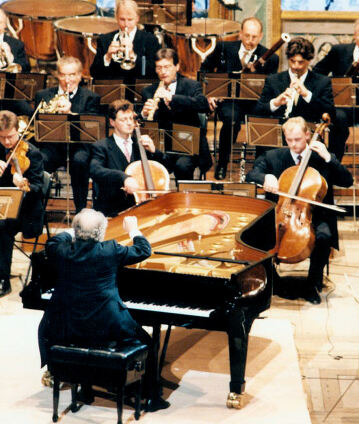Daniel Barenboim conducts the 1997 Europakonzert from Versailles

The Palace of Versailles is the very epitome of Baroque magnificence. In 1997 it was the scene of the Europakonzert given annually by the Berliner Philharmoniker. The conductor was Daniel Barenboim, who was also the soloist in Mozart’s Piano Concerto No. 13. The programme additionally featured Beethoven’s Eroica Symphony and, as a tribute to the venue, Ravel’s Le Tombeau de Couperin, a delightful homage to François Couperin, who was once court composer in Versailles.
In the magnificent setting of the Opéra Royal in the Palace of Versailles, Daniel Barenboim opened the programme with Maurice Ravel’s Le Tombeau de Couperin – a bow, as it were, to this masterpiece of Baroque architecture. The musical genre of the tombeau (literally, a grave or tombstone) is a feature of the French Baroque and was intended as a way of paying homage to a famous musician, usually adapting original music by the composer who was being honoured in this way. Ravel followed this model in Le Tombeau de Couperin, citing dance movements from the Concerts royaux by François Couperin (1668–1733), even though he described the suite as a “homage directed less in fact to Couperin himself than to French music of the eighteenth century”. In spite of this, his work clearly wears the musical garb of the twentieth century.
Unlike Couperin, who was in the service of the “Sun King” Louis XIV for over 20 years, Wolfgang Amadeus Mozart suffered under the constraints of the Salzburg court and settled in Vienna as a freelance musician after his spectacular resignation in 1781: “This is undoubtedly the land of the keyboard!” In 1783 he introduced three new piano concertos to Viennese audiences. Among them was K 415 in C major. He wrote to inform his father that all three works were “a happy medium between what is too difficult and what is too easy – they are very brilliant – pleasing to the ear – and natural without descending into vapidity – there are passages – here and there – from which connoisseurs alone can derive any satisfaction – but these passages are written in such a way that non-connoisseurs, too, cannot fail to be pleased by them, even though they don’t know why.”
Ludwig van Beethoven’s Third Symphony, conversely, was most certainly not felt to be “pleasing to the ear” when it was first performed in Vienna in 1805. Listeners complained that it contained too much that was “strident and bizarre”, while one critic even described it as “morally corrupting”. Today it is regarded as an undisputed masterpiece from a period in Beethoven’s life in which he himself felt that he was writing music “in what is really a completely new manner”.
© 1997 EuroArts Music International
Categories
Artists
Our recommendations
- Daniel Barenboim and Plácido Domingo at the 1992 Europakonzert in the Escorial
- Daniel Barenboim conducts the 2014 Europakonzert in Berlin
- 2010 Europakonzert from Oxford with Daniel Barenboim and Alisa Weilerstein
- Daniel Barenboim conducts Mozart at the 2006 Europakonzert from Prague
- Europakonzert 2012 from Vienna with Gustavo Dudamel and Gautier Capuçon
- 2002 Europakonzert from Palermo with Claudio Abbado and Gil Shaham